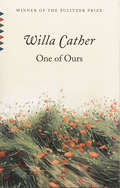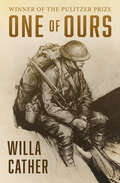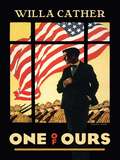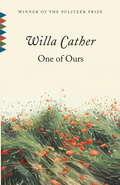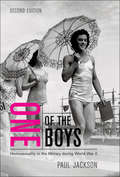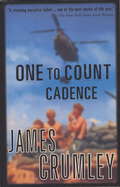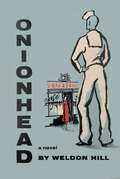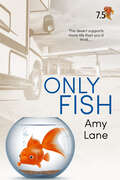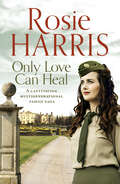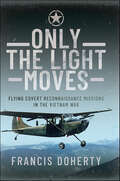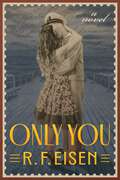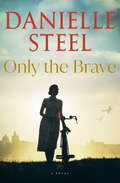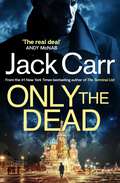- Table View
- List View
One of Ours
by Willa CatherThe son of a prosperous farmer, Claude Wheeler's future is laid out for him as clear and monotonous as the Nebraska sky--a few semesters at the local Christian college followed by marriage and a lifetime spent worrying about the price of wheat. Many young men would be happy to find themselves in Claude's shoes, but his focus is on the horizon, and on the nagging sense that out there, past the farthest reaches of the Great Plains and beyond the boundaries of convention, his true destiny awaits. When the United States finally enters the war raging in Europe, Claude makes the first, and greatest, decision of his life: He answers the call.<P><P> Pulitzer Prize Winner
One of Ours
by Willa CatherWilla Cather&’s Pulitzer Prize–winning novel of World War IThe son of a prosperous farmer, Claude Wheeler&’s future is laid out for him as clear and monotonous as the Nebraska sky—a few semesters at the local Christian college followed by marriage and a lifetime spent worrying about the price of wheat. Many young men would be happy to find themselves in Claude&’s shoes, but his focus is on the horizon, and on the nagging sense that out there, past the farthest reaches of the Great Plains and beyond the boundaries of convention, his true destiny awaits. When the United States finally enters the war raging in Europe, Claude makes the first, and greatest, decision of his life: He answers the call. Based on the experiences of Willa Cather&’s cousin—G. P. Cather received the Distinguished Service Cross and the Silver Star for bravery in World War I—and interviews she conducted with wounded veterans, One of Ours is the indelible portrait of a man—and a nation—on the cusp of profound and irreversible change. This ebook has been professionally proofread to ensure accuracy and readability on all devices.
One of Ours (The Collected Works Of Willa Cather)
by Willa CatherIn Willa Cather's Pulitzer Prize–winning novel, we meet Claude Wheeler, a young Nebraskan yearning to escape the life that has been preordained for him. Claude is dissatisfied with farming, alienated from his parents, distant from his wife, and searching for something to believe in. When the country enters the First World War, he finally discovers what he's been looking for. Away from home for the first time, Claude finds the course of his life irrevocably altered by newfound friendships and experiences on distant battlefields.One of Ours continues to be a celebratory tribute — and a grief-stricken remembrance — of World War I. It is at once a courageous and poignant story of American ideals, an extraordinary character sketch, and a disquieting look at the making of an American soldier.
One of Ours, with some Selected Letters
by Willa CatherWilla Cather's Pulitzer Prize-winning narrative of the making of a young American soldier<P><P> Claude Wheeler, the sensitive, aspiring protagonist of this beautifully modulated novel, resembles the youngest son of a peculiarly American fairy tale. His fortune is ready-made for him, but he refuses to settle for it. Alienated from his crass father and pious mother, all but rejected by a wife who reserves her ardor for missionary work, and dissatisfied with farming, Claude is an idealist without an ideal to cling to. It is only when his country enters the First World War that Claude finds what he has been searching for all his life.<P> In One of Ours Willa Cather explores the destiny of a grandchild of the pioneers, a young Nebraskan whose yearnings impel him toward a frontier bloodier and more distant than the one that vanished before his birth. In doing so, she creates a canny and extraordinarily vital portrait of an American psyche at once skeptical and romantic, restless and heroic.<P> BONUS: The edition includes an excerpt from The Selected Letters of Willa Cather.
One of Them: A Novel
by Kitty ZeldisThe beloved author of Not Our Kind and The Dressmakers of Prospect Heights returns with a story of secrets, friendship, and betrayal about two young women at Vassar in the years after World War II, a powerful and moving tale of prejudice and pride that echoes the cultural and social issues of today.Anne Bishop seems like a typical Vassar sophomore—one of a popular group of privileged WASP friends. None of the girls in her circle has any idea that she’s Jewish, or that her real name is or that her real first name is Miriam. Pretending to be a Gentile has made life easier—as Anne, she no longer suffers the snubs, snide remarks, and daily restrictions Jews face. She enjoys her college life of teas, late-night conversations, and mixers. She turns a blind eye to the casual anti-Semitism that flourishes among her friends and classmates—after all, it's no longer directed at her.But her secret life is threatened when she becomes fascinated by a girl not in her crowd. Delia Goldhush is sophisticated, stylish, brilliant, and unashamedly Jewish—and seems not to care that she’s an outcast among the other students. Knowing that her growing closeness with Delia would be social suicide if it were discovered, Anne keeps their friendship quiet. Delia seems to understand—until a cruelty on Anne’s part drives them apart and sends them scattering to other corners of the world, alone and together.
One of the Boys, Second Edition: Homosexuality in the Military during World War II
by Paul JacksonUsing a wide array of sources - including long-closed court martial records, psychiatric and personnel files, unit war diaries, films, and oral histories - Paul Jackson relates the struggle of queer servicemen of all ranks and branches of the Canadian military to fit in to avoid losing their careers and reputations. He argues that even though homosexual men were often accepted and popular within their units, if they were accused of homosexual behaviour, they were subjected to psychiatric assessments, courts-martial proceedings, prison terms, and dishonourable discharges. An influential and eye-opening study, the author has updated this critically acclaimed work with a new preface that considers depictions of soldiers serving in the war in Afghanistan and the continued silence about homosexual servicemen and women.
One of the Few: A Story of Personal Challenge through the Battle of Britain and Beyond
by Johnny Kent Alexandra KentNew and updated edition: the original autobiography is enhanced by the addition of family photos and extracts from unpublished letters and writings by the author, and a moving and informative new introduction and epilogue by Alexandra Kent, Johnny Kent’s daughter, who presents the father she knew, not only a distinguished and brave war hero but a man who suffered with the scars of war.‘I turned into the attack … The German formation split up and a general mêlée ensued, grey shapes with black crosses on them flashed past only feet away, next the brown and green of a Hurricane flashed across the sights … so confused was the fight that one had little or no chance to see if one’s fire had taken effect before having to take wild evasive action to avoid either the enemy’s fire or a collision.’Group Captain Johnny Kent joined the RAF in the 1930s and went on to become a flight commander of one of the most successful fighter squadrons of the Second World War. In this role, he helped the famous 303 Polish Squadron play a decisive part in the Battle of Britain, and this earned him the highest Polish military award, the Virtuti Militari, as well as the affectionate nickname ‘Kentowski’.Group Captain Kent’s fascinating memoirs, originally published in 1971, tell the story of his life in the RAF, from his struggles as a boy on the Canadian Prairies to get into the air, detailing his experiences as a test pilot in Farnborough and his constant efforts to excel at what he did. In this new edition, alongside the classic tale of derring-do, Kent’s daughter provides supplementary material that places his extraordinary story into the broader context of his life as a son, husband and father. Poignant questions are raised about what it meant to be ‘One of the Few’ – for both the men themselves and those to whom they were closest.
One to Count Cadence
by James CrumleyThe time: late summer, 1962. The place: Clark Air Force Base, the Philippines. Sergeant Jacob "Slag" Krummel, a scholar by intent but a warrior by breeding, assumes command of the 721st Communication Security Deteachment, an unsoldierly crew of bored, rebellious, whoring, foul-mouthed, drunken enlistees. Surviving military absurdities reminiscent of those in Catch-22 only to be shipped clandestinely to Vietnam, Krummel's band confront their worst fears while finally losing faith in America and its myths.Powerful, scathingly funny, and eloquent, One to Count Cadence is a triumphant novel about manhood, anger, war, and lies.
One-Man Airforce [Illustrated Edition]
by Ira Wolfert Major Don Salvatore GentileIllustrated with 14 photos of the Author and the Aircraft he flew.Gentile was born in Piqua, Ohio. After a fascination with flying as a child, his father provided him with his own plane, an Aerosport Biplane. He managed to log over 300 hours flying time by July 1941, when he attempted to join the Army Air Force.The U.S. military required two years of college for its pilots, which Gentile did not have, so he enlisted in the Royal Canadian Air Force and was posted to the UK in 1941. Gentile flew the Supermarine Spitfire Mark V with No. 133 Squadron, one of the famed "Eagle Squadron" during 1942. His first kills (a Ju 88 and Fw 190) were on August 1, 1942, during Operation Jubilee.In September 1942, the Eagle squadrons transferred to the USAAF, becoming the 4th Fighter Group. Gentile became a flight commander in September 1943, now flying the P-47 Thunderbolt. Having been Spitfire pilots, Gentile and the other pilots of the 4th were displeased when they transitioned to the heavy P-47. By late 1943, Group Commander Col. Don Blakeslee pushed for re-equipment with the lighter, more maneuverable P-51 Mustang. Conversion to the P-51B at the end of February 1944 allowed Gentile to build a tally of 15.5 additional aircraft destroyed between March 3 and April 8, 1944. After downing 3 planes on April 8, he was the top scoring 8th Air Force ace when he crashed his personal P-51, named "Shangri La", on April 13, 1944 while stunting over the 4th FG's airfield at Debden for a group of assembled press reporters and movie cameras. Blakeslee immediately grounded Gentile as a result, and he was sent back to the US for a tour selling war bonds. In 1944, Gentile co-wrote with well-known war correspondent Ira Wolfert One Man Air Force, an autobiography and account of his combat missions.
Onionhead: A Novel of the Coast Guard
by Weldon HillAs an insolvent, lonely student at the University of Oklahoma in the days before America's entry into World War II, Al Woods was obsessed with two things: food and sex. He never seemed to have enough of the first, and never seemed to have any of the second. He had known nothing but hard times. He felt himself a member of the Doomed Generation, whose best hope was the least of several evils. Since he thought he was getting nowhere in college, Al joined the Coast Guard; it was better than being drafted, and it offered three square meals a day. Al's story is a novel of the Coast Guard--America's first seagoing outfit, with a tradition that has been neglected in fiction. It is the immensely readable, strongly compelling story of how he became a man through his life in the ships and of how he learned the difference between lust and love through his experiences with the women on shore. There were no heroics in the Coast Guard--at first. There was, for Al, a disillusioning fiasco in the New Orleans' Baronne Street, which made him wonder about all women, and with a special kind of torment, about Josephine Hill, the popular coed at the University to whom he had felt closer than to any other girl. There was routine duty on the buoy tender Skedeelia around the Great Lakes, and the pleasurable discovery that he had the makings of a first-class cook, and the lamentable discovery that in the eyes of his shipmates he had become an "onionhead." There was the growing comradeship with Red Wildoe, his superior in the galley, and with other members of the crew. And there was Stella, whom Al met in a Milwaukee water-front bar. Stella was all woman and all passion. Yet his relationship with her brought a troubling sense that he had betrayed a shipmate's friendship; and for all its sensual satisfactions, something was lacking. He thought that with Jo Hill things would have been different, but her letters told him he had lost her. Before the book is over America has entered the war, Al has seen action in the Atlantic, and learned a lot more about women. Above all he has gained maturity and character, as he proves when he meets the real test of his loyalty. Weldon Hill, a new novelist, has told his story with humor, understanding, and unblinking realism. He has a superb ear for the way people talk, and an innate grasp of how they think and feel.
Onizuka Air Force Base (Images of America)
by Joseph T. IIFor nearly five decades, some of the United States military's most secretive operations were conducted out of a collection of nondescript buildings at the intersection of State Route 237 and Mathilda Avenue in Sunnyvale, California. The installation was known by a variety of names in its early years: Satellite Test Center, Air Force Satellite Control Facility, the "Blue Cube," and Sunnyvale Air Force Station. In July 1986, the facility was renamed Onizuka Air Force Base after Col. Ellison S. Onizuka, the first Asian American astronaut, who was killed during the space shuttle Challenger accident. The location was selected due to its proximity to Lockheed Missiles and Space Company's Sunnyvale facilities and supported early satellite reconnaissance programs such as Corona, Gambit, and Hexagon. As the nation's nucleus for satellite command and control, workers at Onizuka Air Force Base directed efforts for the National Reconnaissance Office (NRO), US military, and NASA's space shuttle program until the closure of the base in 2010.
Only Birds Above
by Portland JonesThis is the story of Arthur Watkins, blacksmith, who leaves his beloved young wife Helen to serve with the 10th Light Horse Battalion in the Middle East in World War I. He returns without his horse, a man forever changed by what he has seen and suffered. Years later, Arthur's children Ruth and Tom are still feeling the effects of the first war when Tom is sent by his father to work in Sumatra. Tom Watkins is there in 1942 when the Japanese invade and is taken prisoner. This is the story of two wars that divide and unite a father and son, and all the years that lie in between.
Only Fish: A Fish Out of Water Collection (Fish Out of Water)
by Amy LaneAmy Lane&’s Fish Out of Water universe has expanded to include garage mechanics, assassins, nurses, psychics, and adult film stars. Many of them forged a safe, hidden haven in Victoriana--the middle of the desert. This collection of shorts revolves mostly around the Victoriana crew—the desert Fish, a group of people with specialized skills, a strong moral code, and an aversion to the rules. Join Burton, Ernie, Ace, Sonny, Jai, and George as they deal with impossible storms, visiting assassins, and—oh yeah—the in-laws, in this series of novellas that shows that being a Fish in the desert isn&’t always easy, but a desert fish can always find a home.
Only Love Can Heal
by Rosie HarrisHer destiny was certain but her heart had other plans . . . An enthralling saga of love and marriage from the beloved author of Stolen Moments. Lieutenant Kate Russell&’s post-war life was all mapped out. According to her upper-class parents&’ wishes, she planned to marry a man with a pedigree like her own. But fate had other ideas in the form of Robert Campbell, a mere staff driver. Kate is irresistibly drawn to him and they decide to wed. Her family, initially outraged by the proposal, agree to accept their marriage but only if Robert climbs the ranks of the army. But when the Allied forces declare victory and Robert goes on to become a Major, Kate finds that she has another bitter war to fight. Trapped by the possessive demands of her aristocratic parents, she fights her own lonely battle to save her marriage and her reputation.
Only Love Can Heal: A Post War Romance
by Rosie HarrisAn English lady of breeding betrays her family by marrying a working-class soldier in this WWII romance from the author of A Mind of Her Own. Lieutenant Kate Russell had her post-war life all mapped out, planning to marry a man with a pedigree as sound as her own. Because confidence, beauty, and privilege were advantages she took for granted. And besides, her aristocratic parents had great plans for her. Then she met Robert Campbell, a mere staff driver. Handsome in a rugged, rawboned sort of way, his lack of breeding both excited and intrigued her. Her family, initially outraged by the proposal, would only accept their marriage if Robert climbed the ranks of the army. But when the Allied forces declare victory and Robert achieves the rank of Major, Kate finds she has another bitter war to fight. Trapped by her parents’ possessive demands, tormented by Robert’s passionate but wayward love, she fights her own lonely battle to save her marriage and her reputation.
Only Love Can Heal: A captivating multigenerational family saga
by Rosie HarrisHer destiny was certain but love had other plans…Lieutenant Kate Russell’s post-war life was all mapped out. According to her upper class parents’ wishes, she planned to marry a man with a pedigree like her own. But fate had other ideas in the form of Robert Campbell, a mere staff driver. Kate is irresistibly drawn to him and they decide to wed. Her family, initially outraged by the proposal, agree to accept their marriage but only if Robert climbs the ranks of the army.But when the Allied forces declare victory and Robert goes on to become a Major, Kate finds that she has another bitter war to fight. Trapped by the possessive demands of her aristocratic parents, she fights her own lonely battle to save her marriage and her reputation.An enthralling saga of love and marriage, perfect for fans of Rosie Goodwin and Anna Jacobs.
Only The Light Moves: Flying Covert Reconnaissance Missions in the Vietnam War
by Francis A. Doherty"Doherty writes from the heart. The descriptions of his missions are nothing less than hair-raising. He describes his struggles with coming to grips with the war and the senseless death of so many young men." — The Journal of the Air Force Historical Foundation Only the Light Moves tells the story of a twenty-four-year-old US Army pilot who volunteered to fly covert S.O.G., or Studies and Observations Group, reconnaissance missions over the Ho Chi Minh Trail, a region that came to represent not only the United States’ war with Vietnam, but also the “secret war” with Laos and Cambodia. But this is not simply a war story; it is a love story about flying. Captain Francis A. Doherty spent every day for ten months above the jungle battlefield in a Cessna O-1 Bird Dog. The first all-metal fixed-wing aircraft ordered for and by the United States Army following the Army Air Forces' separation from it in 1947, the single-engine Bird Dog was a liaison and observation aircraft. And for this role, it was completely unarmed. It was from the cockpit of a Bird Dog that Captain Doherty observed this illusive war, perhaps searching out enemy troop movements or calling down waiting F-4 Phantoms to strike a new target. It was a war in which he followed his father’s footsteps in his dream to become a pilot, and where he learned a compassion that extended both to his comrades and the civilians caught in the middle of that terrible war. In Only the Light Moves Captain Doherty not only reveals the highs and lows of his year at war in Vietnam but expands beyond his time in the conflict. He explores the emotional struggle he and his comrades faced after they returned home, reconciliations with lost faith, and the incredible impact of war on families. We are also given an insight into Francis’ subsequent journey to becoming a commercial airline pilot. His story makes no effort to glorify the violence that took the lives of so many. There are no broad stroke proclamations about the war, only a very personal, sensitive account of a terrible conflict seen through the eyes of a then young pilot in the air, illuminating the reality and the cost of when one's country decides to go to war.
Only With You (Man Enough)
by Nicole McLaughlinThe men in Nicole McLaughlin’s Man Enough series are tough Alphas devoted to serving their country and the women who love them.National Guardsman Aiden King has been attracted to Hannah Walters for a while, but he never made a move because of her close relationship with his best friend. But when circumstances change, Aiden is surprised when his friend gives his blessing. Problem is, there’s a reason he’s still alone after all these years, and as much as he wants her, that secret keeps him from acting on his desires.Hannah has finally decided to wait for the kind of love you read about in books and see in movies. After her failed engagement, Aiden’s unassuming support has become a touchstone for Hannah. It soon becomes apparent that he may be exactly the kind of man she’s been looking for. But the closer they become, the more he keeps her at arm’s length.When Aiden suggests a road trip to take Hannah’s mind off her troubles, the two of them go on a journey neither one expected. She just hopes that the final destination is them together for good.
Only You
by R.F. EisenIn Only You, R.F. Eisen weaves a tale of love and commitment set against the backdrop of World War II. As the war rages on, two lovers, John and Ellen, find their lives torn asunder by chaos, casting seeds of doubt and despair.When a hurricane swamps the USS Warrington, knocking John Ridgeway- "Ridge" to his friends-and his fellow sailors overboard, their lives in imminent danger from sharks and exposure, John keeps faith by remembering the woman he left stateside. Meanwhile, Ellen, his new bride, awaits word from her beloved. The couple remain eager to embark upon a life together, yet world events keep them apart. Throughout their separation, Ellen and John encounter obstacles that a less resilient love could not endure. With meticulous historical detail, Only You immerses readers in a sweeping tale of courage, sacrifice, and the transcendent power of love that resonates for these troubled, modern times.
Only an Heiress Will Do (A Season to Wed)
by Virginia HeathFour soldiers face their greatest battle yet—the Regency marriage mart! Fall in love with the first installment of the Season to Wed miniseries. A marriage made in haste… Repented at leisure? Major Adam Mayhew has returned from war to discover his family facing ruin. He no longer cares for the expectations of the ton, but he needs a wealthy, convenient wife fast! Heartbroken by a scoundrel and with her reputation mud, Gwendolyn Trym agrees to use her sizable dowry to restore Adam&’s fortunes—and he can restore her good name! Then they can both dispense with the chore of marriage. Yet Adam is proving to be too clever, too rebellious and too attractive a husband…and Gwen's plan starts to unravel! From Harlequin Historical: Your romantic escape to the past.A Season to WedBook 1: Only an Heiress Will Do by Virginia HeathBook 2: The Viscount's Forbidden Flirtation by Sarah RodiBook 3: Their Second Chance Season by Ella MatthewsBook 4: The Lord's Maddening Miss by Lucy Morris
Only the Brave: A Novel
by Danielle SteelNEW YORK TIMES BESTSELLER • From #1 New York Times bestselling author Danielle Steel comes a powerful, sweeping historical novel about a courageous woman in World War II Germany.Sophia Alexander, the beautiful daughter of a famous surgeon in Berlin, has had to grow up faster than most young women. When her mother falls ill, Sophia must take charge of her younger sister, Theresa, and look after her father and the household, while also volunteering at his hospital after school. Meanwhile, Hitler&’s rise to power and the violence in her very own town have Sophia concerned, but only her mother is willing to share her fears openly.After tragedy strikes and her mother dies, Sophia becomes increasingly involved in the resistance, attending meetings of dissidents and helping however she can. Circumstances become increasingly dangerous and personal when Sophia assists her sister&’s daring escape from Germany, as Theresa flees with her young husband and his family. Her father also begins to resist the regime, secretly healing those hiding from persecution, only to have his hospital burned to the ground. When he is arrested and sent to a concentration camp, Sophia is truly on her own, but more determined than ever to help.While working as a nurse with the convent nuns, the Sisters of Mercy, Sophia continues her harrowing efforts to transport Jewish children to safety and finds herself under surveillance. As the political tensions rise and the brutal oppression continues, Sophia is undeterred, risking it all, even her own freedom, as she rises to the challenge of helping those in need—no matter the cost.In Only the Brave, Danielle Steel vividly captures the devastating effects of war alongside beautiful moments of compassion and courage.
Only the Brave: July 1944--The Epic Battle for Guam (American War Heroes)
by Don KeithFor Dutton Caliber's American War Heroes series, a World War II narrative on the American liberation of Guam in 1944, focusing on the twenty days of intense combat as the Marine Corps took the island back from the Japanese.On July 21, 1944, a US Marine division landed on the beaches of Guam, a once sleepy island in the Pacific that had been seized from the Americans by the Japanese in the hours after Pearl Harbor. The Japanese would not be giving Guam up easily. The large enemy force defended the island viciously, punching holes through the American lines, attacking from the flanks, and eventually resorting to banzai suicide attacks. The fighting was bloody and brutal, every bit as deadly as Iwo Jima or Okinawa would be. Now, acclaimed author Don Keith offers up a compelling account of one of the toughest fights of the Pacific War, a battle that led to ten thousand American casualties and four Medals of Honor.
Only the Dead: James Reece 6
by Jack Carr**NOW AN AMAZON PRIME TV SERIES STARRING CHRIS PRATT** 'Take my word for it, James Reece is one rowdy motherf***er. Get ready!' CHRIS PRATT JAMES REECE IS BACK 1978, Rhode Island: A freshman senator is gunned down, sending shockwaves through Washington that are still reverberating over four decades later. Now: In a world on the brink of war, facing rampant inflation, political division and shocking assassinations, a secret cabal of global elites are ready to assume control. And with the world&’s most dangerous man locked in solitary confinement, the conspirators believe the final obstacle to complete domination has been eliminated. They&’re wrong. From the firms of Wall Street to the corridors of power in Washington, DC and Moscow, secrets from the past have an uncanny ability to rise to the surface, and with the odds stacked against him, James Reece is on a deadly mission generations in the making. But for a man on the warpath, odds are not important . . . Intoxicating and timely, Only the Dead cements Jack Carr as 'a rare gut-punch writer, full of grit and insight' (Gregg Hurwitz, New York Times bestselling author). Fans of Tom Clancy&’s Jack Ryan, Lee Child's Jack Reacher or Vince Flynn's Mitch Rapp will love the James Reece series!Praise for Jack Carr: 'A propulsive and compulsive series. Jack Carr&’s James Reece is the kind of guy you&’d want to have in your corner. A suspenseful and exhilarating thrill-ride. Jack Carr is the real deal' Andy McNab 'This is seriously good . . . the suspense is unrelenting, and the tradecraft is so authentic the government will probably ban it – so read it while you can!' Lee Child 'With a particular line in authentic tradecraft, this fabulously unrelenting thrill-ride was a struggle to put down' Mark Dawson 'Gritty, raw and brilliant!' Tom Marcus 'So powerful, so pulse-pounding, so well-written – rarely do you read a debut novel this damn good' Brad Thor 'Carr writes both from the gut and a seemingly infinite reservoir of knowledge in the methods of human combat. Loved it!' Chris Hauty 'A powerful, thoughtful, realistic, at times terrifying thriller that I could not put down. A terrific addition to the genre, Jack Carr and his alter-ego protagonist, James Reece, continue to blow me away' Mark Greaney 'Thrilling' Publishers Weekly
Only the Dead: James Reece 6
by Jack Carr**NOW AN AMAZON PRIME TV SERIES STARRING CHRIS PRATT** 'Take my word for it, James Reece is one rowdy motherf***er. Get ready!' CHRIS PRATT JAMES REECE IS BACK 1978, Rhode Island: A freshman senator is gunned down, sending shockwaves through Washington that are still reverberating over four decades later. Now: In a world on the brink of war, facing rampant inflation, political division and shocking assassinations, a secret cabal of global elites are ready to assume control. And with the world&’s most dangerous man locked in solitary confinement, the conspirators believe the final obstacle to complete domination has been eliminated. They&’re wrong. From the firms of Wall Street to the corridors of power in Washington, DC and Moscow, secrets from the past have an uncanny ability to rise to the surface, and with the odds stacked against him, James Reece is on a deadly mission generations in the making. But for a man on the warpath, odds are not important . . . Intoxicating and timely, Only the Dead cements Jack Carr as 'a rare gut-punch writer, full of grit and insight' (Gregg Hurwitz, New York Times bestselling author). Fans of Tom Clancy&’s Jack Ryan, Lee Child's Jack Reacher or Vince Flynn's Mitch Rapp will love the James Reece series!Praise for Jack Carr: 'A propulsive and compulsive series. Jack Carr&’s James Reece is the kind of guy you&’d want to have in your corner. A suspenseful and exhilarating thrill-ride. Jack Carr is the real deal' Andy McNab 'This is seriously good . . . the suspense is unrelenting, and the tradecraft is so authentic the government will probably ban it – so read it while you can!' Lee Child 'With a particular line in authentic tradecraft, this fabulously unrelenting thrill-ride was a struggle to put down' Mark Dawson 'Gritty, raw and brilliant!' Tom Marcus 'So powerful, so pulse-pounding, so well-written – rarely do you read a debut novel this damn good' Brad Thor 'Carr writes both from the gut and a seemingly infinite reservoir of knowledge in the methods of human combat. Loved it!' Chris Hauty 'A powerful, thoughtful, realistic, at times terrifying thriller that I could not put down. A terrific addition to the genre, Jack Carr and his alter-ego protagonist, James Reece, continue to blow me away' Mark Greaney 'Thrilling' Publishers Weekly
Only the River: A Novel
by Anne RaeffA family displaced by World War II finds a new home in Central America, only to watch their fortunes rise and fall on the back of a revolution—from the California Book Award silver medalist and Simpson Literary Prize finalist.Fleeing the ravages of wartime Vienna, Pepa and her family find safe harbor in the small town of El Castillo, on the banks of the San Juan River in Nicaragua. There her parents seek to eradicate yellow fever while Pepa falls under the spell of the jungle and the town’s eccentric inhabitants. But Pepa’s life―including her relationship with local boy Guillermo―comes to a halt when her family abruptly moves to New York, leaving the young girl disoriented and heartbroken.As the years pass, Pepa’s and Guillermo’s lives diverge, and Guillermo’s homeland slips into chaos. Nicaragua soon becomes engulfed in revolutionary fervor as the Sandinista movement vies for the nation’s soul. Guillermo’s daughter transforms into an accidental revolutionary. Pepa’s son defies his parents’ wishes and joins the revolution in Nicaragua, only to disappear into the jungle. It will take decades before the fates of these two families converge again, revealing how love, grief, and passion are intertwined with a nation’s destiny.Spanning generations and several wars, Only the River explores the way displacement both destroys two families and creates new ones, sparking a revolution that changes their lives in the most unexpected ways.
